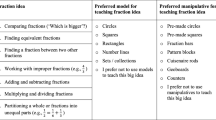Abstract
The topic of Fractions has long been an area of major emphasis in mathematics education and continues to be a major challenge faced by elementary and middle school teachers. The study described in this chapter investigated the similarities and differences in the use of manipulatives for teaching fractions in two elementary schools (termed Sister Schools). Data were collected through Skype meetings; formal and informal conversations with teachers in both schools; and inter-school visits among school administrators and teachers in the two schools, classroom video clips, the sharing/exchange of documents, texts, teaching materials, and other teaching-learning resources. Our results show that, in the Canadian school, various concrete manipulatives are widely used to teach fractions—with pattern blocks, Cuisenaire rods, and fraction strips as the main ones, while pictorial manipulatives are far less used. In the Chinese school, pictorial manipulatives are widely used to teach fractions, while concrete manipulatives are infrequently used.
Access this chapter
Tax calculation will be finalised at checkout
Purchases are for personal use only
Similar content being viewed by others
References
Behr, M., & Post, T. (1992). Teaching rational number and decimal concepts. In T. Post (Ed.), Teaching mathematics in grades K-8: Research-based methods (2nd ed., pp. 201–248). Boston, MA: Allyn and Bacon.
Bezuk, N., & Cramer, K. (1989). Teaching about fractions: What, when, and how? [Electronic version]. In P. Trafton (Ed.), National council of teachers of mathematics 1989 yearbook: New directions for elementary school mathematics (pp. 156–167). Reston, VA: National Council of Teachers of Mathematics.
Cramer, K., & Wyberg, T. (2009). Efficacy of different concrete models for teaching the part-whole construct for fractions. Mathematical Thinking and Learning, 11(4), 226–257.
Lamon, S. J. (2005). Teaching fractions and ratios for understanding: Essential content knowledge and instructional strategies for teachers. Mahwah, NJ: Lawrence Erlbaum Associates.
Lamon, S. J. (2007). Rational numbers and proportional reasoning: Toward a theoretical framework. In F. Lester (Ed.), Second handbook of research on mathematics teaching and learning (pp. 629–668). Charlotte, NC: Information Age Publishing.
Larbi, E., & Mavis, O. (2016). The use of manipulatives in mathematics education. Journal of Education and Practice, 7(36), 53–61.
Kira, J., Scott, M., & James, P. (2013). A meta-analysis of the efficacy of teaching mathematics with concrete manipulatives. Journal of Educational Psychology, 105(2), 380–400.
Kulm, G. (1999). Evaluating mathematics textbooks. Basic Education, 43(9). Retrieved from http://www.project2061.org/publications/articales/articles/cbe.htm.
Moore, S. D. (2014). Why teach mathematics with manipulatives? ETA hand2mind Research summary, 1–4.
Peng, A., Ezeife, A. N., & Yu, B. (2018). Reciprocal learning in mathematics education: An interactive study between two Canadian and Chinese elementary schools. Comparative and International Education, 47(1), 1–14.
Peng, A., & Nyroos, M. (2012). Values in effective mathematics lessons in Sweden: What do they tell us? The Mathematics Enthusiast, 9(3), 409–429.
Post, T. (1981). The Role of Manipulative Materials in the Learning of Mathematical Concepts. Selected Issues in Mathematics Education (pp. 109–131). Berkeley, CA: National Society for the Study of Education and National Council of Teachers of Mathematics, McCutchan Publishing Corporation.
Ruzic, R., & O’Conell, K. (2001). Manipulatives. Enhancement literature review. Retrieved from https://www.cast.org/ncac/Manipulatives1666.cfm.
Sebesta, L. M., & Martin, S. R. M. (2004). Fractions: Building a foundation with concrete manipulatives. Illinois Schools Journal, 83(2), 3–23.
Sherman, J., & Bisanz, J. (2009). Equivalence in symbolic and nonsymbolic contexts: Benefits of solving problems with manipulatives. Journal of Educational Psychology, 101, 88–100.
http://dx.doi.org/10.1037/a0013156 Wikipedia Encyclopaedia. (2018, September 21). Manipulative (Mathematics education). Retrieved from https://en.wikipedia.org/wiki/Manipulative_(mathematics_education).
Wilkerson, T., Cooper, S., Montgomery, M., Gupta, D., Mechell, S., Arterbury, K., et al. (2015). An investigation of fraction models in early elementary grades: A mixed-methods approach. Journal of Research in Childhood Education, 29(1), 1–25.
Xu, S., & Connelly, M. (2014). Partnership grant reciprocal learning in teacher education and school education between Canada and China. Retrieved from http://www.reciprocal-learning.ca/pages.php.
Acknowledgement
The researchers gratefully acknowledge the grant from the Social Sciences and Humanities Research Council (SSHRC) of Canada, which funds the larger Reciprocal Learning Canada-China Partnership Project (898-2021-1011, Xu & Connelly, 2019), and on which this mathematics-focused study is based. The National Social Science Foundation in China (17XMZ032), which also partially funded the study, is also hereby appreciated.
Author information
Authors and Affiliations
Corresponding author
Editor information
Editors and Affiliations
Rights and permissions
Copyright information
© 2020 The Author(s)
About this chapter
Cite this chapter
Peng, A., Ezeife, A.N., Yu, B. (2020). The Use of Manipulatives for Teaching Fractions in Two Canadian and Chinese Elementary Schools: A Comparative Research Analysis. In: Zhu, S.C., Xie, S., Ma, Y., McDougall, D. (eds) Reciprocal Learning for Cross-Cultural Mathematics Education . Intercultural Reciprocal Learning in Chinese and Western Education. Palgrave Macmillan, Cham. https://doi.org/10.1007/978-3-030-56838-2_12
Download citation
DOI: https://doi.org/10.1007/978-3-030-56838-2_12
Published:
Publisher Name: Palgrave Macmillan, Cham
Print ISBN: 978-3-030-56837-5
Online ISBN: 978-3-030-56838-2
eBook Packages: EducationEducation (R0)




